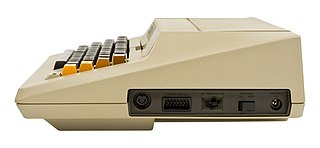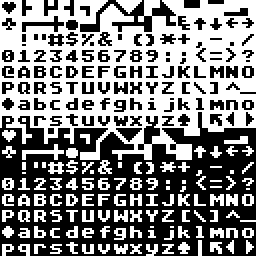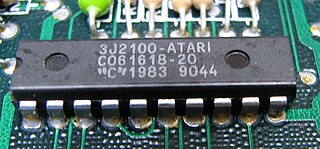 W
WThe Atari 8-bit family is a series of 8-bit home computers introduced by Atari, Inc. in 1979 as the Atari 400 and Atari 800 and manufactured until 1992. All of the machines in the family are technically similar and differ primarily in packaging. They are based on the MOS Technology 6502 CPU running at 1.79 MHz, and were the first home computers designed with custom coprocessor chips. This architecture enabled graphics and sound more advanced than contemporary machines, and gaming was a major draw. First-person space combat simulator Star Raiders is considered the platform's killer app. The systems launched with plug and play peripherals using the Atari SIO serial bus, an early analog of USB.
 W
WThe Atari 1020 was a four-colour computer plotter sold by Atari, Inc. for the Atari 8-bit home computers.
 W
WAlphanumeric Television Interface Controller (ANTIC) is an LSI ASIC dedicated to generating 2D computer graphics to be shown on a television screen or computer display. Under the direction of Jay Miner, the chip was designed in 1977-1978 by Joe Decuir, Francois Michel, and Steve Smith for the Atari 8-bit family of home computers first released in 1979 and was patented by Atari, Inc. in 1981. ANTIC is also used in the Atari 5200 video game system released in 1982, which shares most of the same hardware as the 8-bit computers.
 W
WThe Atari CX40 single-button digital joystick was the first widely used cross-platform game controller. The original CX10 was released with the Atari Video Computer System in 1977 and became the primary input device for most games on the platform. The CX10 was replaced after a year by the simpler and less expensive CX40. The addition of the Atari joystick port to other platforms cemented its popularity. It was the standard for the Atari 8-bit family of home computers and was compatible with the VIC-20, Commodore 64 and 128, MSX, and later the Atari ST and Amiga. Third-party adapters allowed it to be used on other systems, such as the Apple II and the ZX Spectrum.
 W
WThe Serial Input/Output system, universally known as SIO, was a proprietary peripheral bus and related software protocol stacks used on the Atari 8-bit family to provide most input/output duties for those computers. Unlike most I/O systems of the era, such as RS-232, SIO included a lightweight protocol that allowed multiple devices to be attached to a single daisy-chained port that supported dozens of devices. It also supported plug-and-play operations. SIO's designer, Joe Decuir, credits his work on the system as the basis of USB.
 W
WThe Atari XE Video Game System is an industrial redesign of the Atari 65XE home computer and the final model in the Atari 8-bit family. It was released by Atari Corporation in 1987 and marketed as a home video game console alongside the Nintendo Entertainment System, Sega's Master System, and Atari's own Atari 7800. The XEGS is compatible with existing Atari 8-bit family hardware and software. Without keyboard, the system operates as a stand-alone game console. With the keyboard, it boots identically to the Atari XE computers. Atari packaged the XEGS as a basic set consisting of only the console and joystick, and as a deluxe set consisting of the console, keyboard, CX40 joystick, and XG-1 light gun.
 W
WThe Atari XG-1 light gun is a controller bundled with the Atari XEGS which was released in 1987 and is compatible with the Atari 7800 and Atari 2600. The XEGS, where "GS" stands for "game system", is an Atari 65XE computer with the form factor of a game console. The XEGS shipped with one light gun game, Bug Hunt. Atari eventually released five games on the 7800 that use the controller: Alien Brigade, Barnyard Blaster, Crossbow, Meltdown, and Sentinel.
 W
WAtariLab was a laboratory instrumentation system and related computer software for the Atari 8-bit family intended to be used in a high school science classroom setting. The concept was developed by Priscilla Laws, a physics professor at Dickinson College, and developed in partnership with Atari, Inc.. The AtariLab Starter Set with the Temperature Module was released in late 1983, and followed by the add-on Light Module in February 1984. Several other modules were planned for future release.
 W
WThe ATASCII character set, from ATARI Standard Code for Information Interchange, alternatively ATARI ASCII, is the variation on ASCII used in the Atari 8-bit family of home computers. The first of this family were the Atari 400 and 800, released in 1979, and later models were released throughout the 1980s. The last computer to use the ATASCII character set was the Atari XEGS which was released in 1987. The Atari ST family of computers used the different Atari ST character set.
 W
Wcc65 is a cross development package for 65(C)02 systems, including a macro assembler, a C cross compiler, linker, librarian and several other tools.
 W
WColor Television Interface Adaptor (CTIA) and its successor Graphic Television Interface Adaptor (GTIA) are custom chips used in the Atari 8-bit family of computers and in the Atari 5200 home video game console. In these systems, a CTIA or GTIA chip works together with ANTIC to produce the video display. ANTIC generates the playfield graphics while CTIA/GTIA provides the color for the playfield and adds overlay objects known as player/missile graphics (sprites). Under the direction of Jay Miner, the CTIA/GTIA chips were designed by George McLeod with technical assistance of Steve Smith.
 W
WDe Re Atari, subtitled "A Guide to Effective Programming," is a book written by Atari, Inc. employees in 1981 and published by the Atari Program Exchange in 1982 as an unbound, shrink-wrapped set of three-holed punched pages. Targeted at developers, it documents the advanced features of the Atari 8-bit family of home computers and includes ideas for how to use them in applications. The information in the book was not available in a single, collected source at the time of publication.
 W
WFREDDIE is the name for a 40-pin LSI found in later model Atari 8-bit computers. It is a RAM address multiplexer, used for DRAM access. Atari created this chip to replace several other chips to cut costs and to enhance CPU and ANTIC memory access.
 W
WHappy drives are series of disk drive enhancements for the Atari 8-bit and Atari ST computer families produced by a small company Happy Computers. Happy Computers is most noted for the add-in boards for the Atari 810 and Atari 1050 disk drives, which achieved a tremendous speed improvement for reading and writing, and for the ability to "back up" floppies. Happy's products were among the most popular Atari computer add-ons. They were still in use and active in the aftermarket as of 2009.
 W
WThe KoalaPad is a graphics tablet, released in 1983 by U.S. company Koala Technologies, for the Apple II, TRS-80 Color Computer, Atari 8-bit family, and Commodore 64, as well as for the IBM PC.
 W
WLenslok is a copy protection mechanism found in some computer games and other software on the 8-bit Atari computers, Commodore 64, Sinclair ZX Spectrum, Sinclair QL, MSX and Amstrad CPC. The most well-known game to use it was Elite for the ZX Spectrum.
 W
WMapping the Atari, written by Ian Chadwick and published by COMPUTE! Publications in 1983, is a location-by-location explanation of the memory layout of the Atari 8-bit family of home computers. The introduction is by Optimized Systems Software co-founder Bill Wilkinson.
 W
WAtari MMU is a custom memory management unit chip for the Atari 8-bit computers. It enables access to the hardware registers on ANTIC, GTIA, POKEY and 6520 PIA. The later XL/XE MMU (C061618) also selects OS ROM, Atari BASIC ROM, self-test ROM and LEDs in the 1200XL. On the 128K 130XE the EMMU chip handles similar functionality.
 W
WThe Parallel Bus Interface, or PBI, is a 50-pin port found on some Atari 8-bit XL computers. It provides unbuffered, direct connection to the system bus lines, running at the same speed as the 6502 CPU. The 600XL and 800XL computers, along with the unreleased 1400XL and 1450XLD had a PBI interface.
 W
WThe Pot Keyboard Integrated Circuit (POKEY) is a digital I/O chip designed for the Atari 8-bit family of home computers and found in Atari arcade games of the 1980s. POKEY combines functions for sampling potentiometers and scan matrices of switches as well as sound generation. It produces four voices of distinctive square wave sound, either as clear tones or modified with a number of distortion settings.